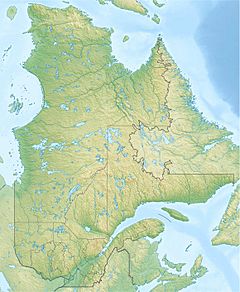Saint-Paul River facts for kids
Quick facts for kids Saint-Paul River |
|
|---|---|
| Native name | Aiahtshimeu Hipu |
| Other name(s) | Rivière Saint-Paul |
| Country | Canada |
| Province | Quebec |
| Region | Côte-Nord |
| RCM | Le Golfe-du-Saint-Laurent |
| Physical characteristics | |
| River mouth | Gulf of Saint Lawrence 0 metres (0 ft) 51°28′10″N 57°42′05″W / 51.4694444°N 57.7013889°W |
| Length | 246 kilometres (153 mi) |
| Basin features | |
| Basin size | 7,158 square kilometres (2,764 sq mi) |
The Saint-Paul River (French: Rivière Saint-Paul) is an important river in the Côte-Nord region of Quebec, Canada. It is well-known for its salmon and flows into the large Gulf of Saint Lawrence. This river has a rich history and is a great place for fishing.
Contents
About the Saint-Paul River
Where is the Saint-Paul River?
The Saint-Paul River starts high up in the land between the Atlantic Ocean and the Saint Lawrence River. It flows mostly south. The river is about 246 kilometres (153 mi) (153 miles) long. A big part of it, about 146 kilometres (91 mi) (91 miles), is in Labrador.
The river ends in Esquimaux Bay. This bay is part of the Vieux Fort archipelago. It is about 35 kilometres (22 mi) (22 miles) west of Blanc-Sablon. The last 15 kilometres (9.3 mi) (9 miles) of the river forms a border between two areas called Chevalier and Bonne-Esperance. The river's mouth is in the town of Bonne-Espérance. There is also a village called Rivière-Saint-Paul right at the river's mouth.
What's in a Name?
The Saint-Paul River has had many names over time. The Inuit people, who lived near the river's mouth, called it the Quitzezaqui River. This name means "Great River." The Naskapi people call it Aisimeu Shipu, and the Innu people call it Aiahtshimeu Hipu. Both of these names mean "Eskimo River."
In 1694, a French explorer named Louis Jolliet arrived at the river. He named it Rivière des Esquimaux. It was also sometimes called Grande Rivière, meaning "Great River." Later, in 1706, a man named Jean-Amador Godefroy de Saint-Paul was given permission to trade at the river's mouth. After this, the river was renamed the Rivière Saint-Paul, which is what we call it today.
The River's Home: Its Basin
A river's basin is all the land where water flows into that river. The Saint-Paul River's basin covers a huge area of 7,158 square kilometres (2,764 sq mi) (2,764 sq mi). This basin is located between two other river basins: the Napetipi River to the west and the Belles Amours River to the east.
Most of the basin, about 69.5%, is in Labrador, north of the border with Quebec. The part of the basin in Quebec is found in the wild area of Petit-Mécatina and in the town of Bonne-Espérance. Part of the river basin is also planned to become a special area called the Basses Collines du Lac Guernesé Biodiversity Reserve. This reserve helps protect nature.
Ancient Visitors: Basque Presence
In 2019, a team of underwater archaeologists found something amazing. They explored four old fishing sites on the Saint-Paul River. These sites were from the 16th century, which is over 500 years ago!
At these sites, they found many objects. These included cooking pots, pottery, roof tiles, and ship nails. The Inuit people likely bought these items from the Basques. The Basques were people from a region between Spain and France who came to North America to fish and trade.
This discovery was very important. It showed that the Inuit people living there were settled in one place, not always moving around. It also suggested that the Basques had closer relationships with the local people than experts had thought before. These old objects were found both in the river and on its banks.
Fishing in the Saint-Paul River
Atlantic Salmon and Other Fish
The Saint-Paul River is famous for its Atlantic salmon (Salmo salar). These fish are a big reason why people visit the river. The riverbed is made of medium-sized rocks, and the water is cold and clear. This makes it a perfect home for Atlantic salmon.
The fishing season for salmon usually runs from mid-June to mid-August. In recent years (2013-2017), about 126 salmon were caught in the river each year. In 2018, people were allowed to keep large salmon for only part of the year. The river actually met its goals for salmon management that year! This meant that in August 2018, anglers could keep one large salmon (63 centimetres (25 in) or longer) from the Saint-Paul and a few other rivers like the Gros Mécatina and Napetipi.
Besides salmon, you can also find other fish near the river's mouth. These include American eel (Anguilla rostrata), brook trout (Salvelinus fontinalis), and rainbow smelt (Osmerus mordax).
Fishing Services and Outfitters
If you want to go fishing on the Saint-Paul River, there are special services called "outfitters" that can help. The Club de pêche au saumon Saint-Paul (Saint-Paul Salmon Fishing Club) is one of them. This club has special rights to a part of the river about 60 kilometres (37 mi) (37 miles) upstream. This area has many islands and rapids. The club offers cabins, canoes, and guided fishing trips for Atlantic Salmon. To get to their camp, you usually need to take a charter float plane or a helicopter.
Another outfitter is Pourvoirie Green Point. They have exclusive rights to 17 kilometres (11 mi) (11 miles) of the river. This section starts about 3 kilometres (1.9 mi) (2 miles) from the river's mouth and goes up to Green Point Rapids. Their services include air travel from Blanc-Sablon, guided fishing, and places to stay in camps along the river.


